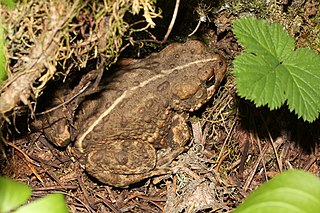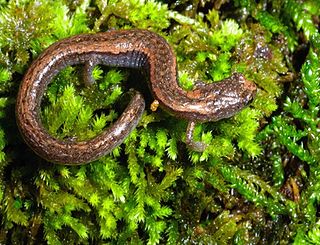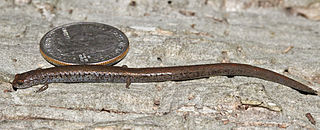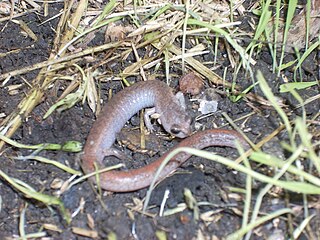
California mixed evergreen forest is a plant community found in the mountain ranges of California and southwestern Oregon.

The black-bellied slender salamander is a small species of salamander that is endemic to California.

The western toad is a large toad species, between 5.6 and 13 cm long, native to western North America. A. boreas is frequently encountered during the wet season on roads, or near water at other times. It can jump a considerable distance for a toad. Breeding occurs between March and July in mountainous areas, and as early as January in lower-elevation regions. The female lays up to 17,000 eggs stuck together in strings that adhere to vegetation and other objects along water edges.

The California slender salamander is a lungless salamander that is found primarily in coastal mountain areas of Northern California, United States as well as in a limited part of the western foothills of the Sierra Nevada, California, in patches of the northern Central Valley of California, and in extreme southwestern Oregon. This species resides primarily in a limited range within California as one of a handful quasi-endemic amphibians in the state.

The Inyo Mountains salamander or Inyo slender salamander is a species of salamander in the family Plethodontidae that is endemic to the Inyo Mountains of California in the western United States.

The Gabilan Mountains slender salamander is a species of salamander in the family Plethodontidae. It is endemic to California in the United States, where it is distributed along the Central Coast region from Santa Cruz to northern Kern County.

The sequoia slender salamander is a species of salamander in the family Plethodontidae. It is endemic to California, in Tulare County in the western United States.

The Santa Lucia Mountains slender salamander is a species of salamander in the family Plethodontidae. It is endemic to California in the United States, where it is known only from Monterey County.

The Garden slender salamander or Southern California slender salamander is a species of salamander in the family Plethodontidae. It is endemic to northern Baja California in Mexico and Southern California in the United States.

The lesser slender salamander is a species of salamander in the family Plethodontidae.

The Channel Islands slender salamander is a species of salamander in the family Plethodontidae. Due to cool and foggy conditions on the islands where it lives, it is one of the only slender salamanders in California that can be active year-round.
The Kings River slender salamander is a species of salamander in the family Plethodontidae. It is endemic to California, in Fresno County in the western United States.

The relictual slender salamander is a species of salamander in the family Plethodontidae. It is endemic to California, found only a small area in Kern County, California.
The Kern Plateau salamander is a species of salamander in the family Plethodontidae, endemic to California, in Tulare and Inyo, and Kern Counties in the western United States.

The Oregon slender salamander is a species of salamander in the family Plethodontidae from the Northwestern United States.
The Mediterranean California lower montane black oak–conifer forest is a major forest association and ecosystem of the California mixed evergreen forest bioregion in certain mountain ranges in California and southern Oregon in the Western United States; and Baja California in northwest Mexico.
Elizabeth L. Jockusch is an American evolutionary biologist who studies plethodontidae salamanders and other organisms. While working with David Wake and others, she has identified multiple new species of Batrachoseps salamanders. She works as a professor and lab director of the Jockusch Lab in the Department of Ecology and Evolutionary Biology at the University of Connecticut.
The Arguello slender salamander is a species of salamander in the family Plethodontidae. It is endemic to California, where it is found only in a small area of coastal Santa Barbara County.














